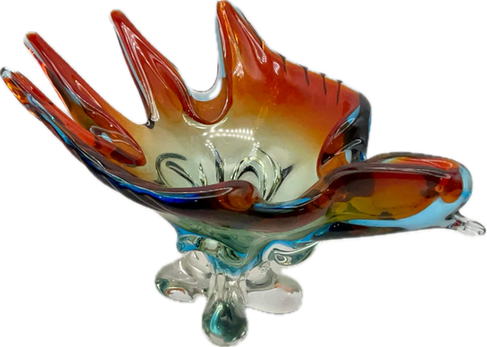Glass Legends: The EDAG Tie-dye, Canadian Vintage Art Glass
- lunasabrina
- Feb 4, 2024
- 3 min read
Welcome to the latest installment of 'Glass Legends,' a series that's dedicated to highlighting extraordinary and rare glass artifacts from around the world, including notable pieces from the rich tradition of Canadian vintage art glass. This journey is akin to uncovering mythical legends—stories of awe-inspiring pieces that are often spoken about but seldom witnessed. Until now, our exploration has revealed two remarkable legends: one from the esteemed Canadian vintage art glass studio, EDAG, and the other from the renowned Chalet. For those interested in delving into the EDAG legend, [click here], and to explore the Chalet glass legend, [click here].
Welcome to the latest installment of 'Glass Legends,' a series that's dedicated to highlighting extraordinary and rare glass artifacts from around the world, including notable pieces from the rich tradition of Canadian vintage art glass
In today's entry, we venture beyond the realm of form to discover a legend defined by its mesmerizing color palette. I am thrilled to unveil the EDAG tie-dye—a piece unparalleled in its clarity and vibrancy of color effect, a rarity yet to be matched in the world of glass art. This particular tie-dye colorway has been named by collectors, inspired by the distinctive hues that many from Lorraine Glass Industries creations have. The name 'tie-dye' aptly reflects the piece's eclectic color scheme, marked by sharp transitions between shades.

The Lorraine signature typically features a bold burgundy red that seamlessly flows into a subdued yellow, transitions into a gentle green, and culminates in a serene blue boundary. While the intensity and vibrancy of these colors may vary, this distinctive combination is a hallmark of their pieces. The EDAG tie-dye stands as a testament to this tradition, presenting a palette that captivates and mesmerizes, inviting us to appreciate the profound beauty and craftsmanship inherent in the world of vintage glass art.
Upon its initial discovery, the EDAG spike and curl piece sparked immediate intrigue, though it was hastily and mistakenly identified as a creation from Lorraine, largely due to its striking tie-dye coloring. It's crucial to recognize the pitfalls of relying solely on color for glass identification; while color can be informative, it ranks lower in the hierarchy of identification criteria. Primarily, one should examine the form, tool marks, and the base of the piece.
This particular artifact bears the quintessential hallmarks of an EDAG spike and curl: it features elongated, slender pulls with a notably extended and pronounced curl situated opposite the spike, distinguishing it from the shorter curls on the sides. Both the base of the piece and the distinctive U-pushes are signature EDAG elements. The craftsmanship between the pulls, marked by specific tooling techniques, further confirms its EDAG origins.

To illustrate these differences more vividly, I've juxtaposed this EDAG piece with a Lorraine tie-dye spike and curl. The comparison highlights the Lorraine's thicker pulls, the uniform height of the curls, and a distinct base and tooling structure. When viewed side by side, the unique characteristics of each piece become unmistakably evident.
This exploration within the "Glass Legends" series not only sheds light on a unique piece but also serves as a valuable lesson in the multifaceted approach required for accurate glass attribution. For those interested in delving deeper into the art of tooling, I invite you to read my detailed article by clicking here.

Turning our attention to the colorway of this elusive EDAG tie-dye, we observe a rim tinged with red, setting it apart from the typically deeper burgundy tone associated with Lorraine pieces. Unlike Lorraine's broader burgundy rims, the EDAG showcases a distinctly delineated edge. Dominating the body of the EDAG piece is a vibrant green hue, with less emphasis on the yellow transition seen in Lorraine pieces. Additionally, a clear sommerso line in blue encases the other colors, culminating in a layer of clear glass, showcasing a masterful blend of hues.
Comparing this with a Lorraine bird, one might notice similarities in the color scheme, yet the shades and their arrangement diverge significantly. This distinction becomes even more apparent when examining the different color layouts in a Lorraine basket and stretch piece. While the bird may share some color similarities, the nuances in hue and composition underscore the unique identity of each piece.
























